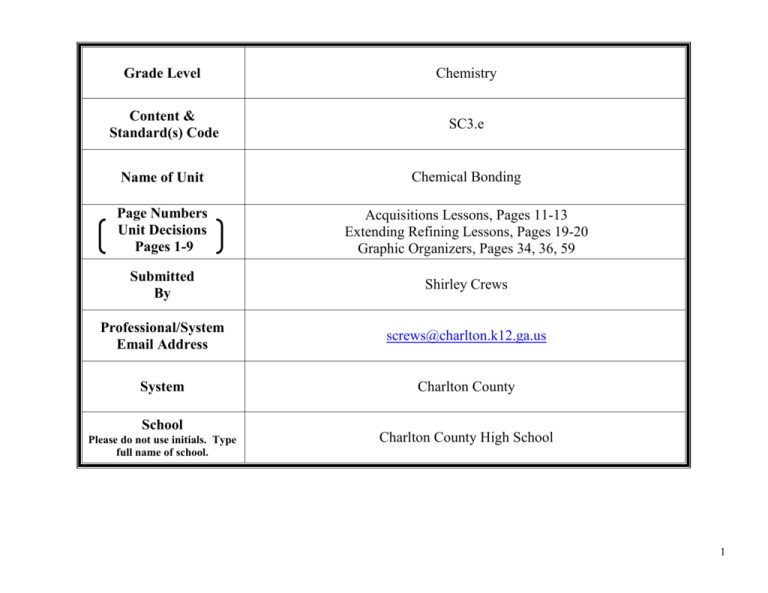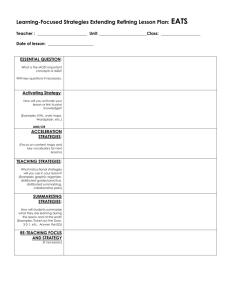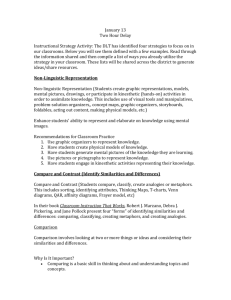Decision Two: The performance or product project
advertisement

Grade Level Chemistry Content & Standard(s) Code SC3.e Name of Unit Chemical Bonding Page Numbers Unit Decisions Pages 1-9 Acquisitions Lessons, Pages 11-13 Extending Refining Lessons, Pages 19-20 Graphic Organizers, Pages 34, 36, 59 Submitted By Shirley Crews Professional/System Email Address screws@charlton.k12.ga.us System Charlton County School Please do not use initials. Type full name of school. Charlton County High School 1 Created by: Shirley Crews Decision Two: The performance or product project that will be the culminating activity of the unit Note: Decision One is the Content Map Students’ Assignment Page for the Culminating Activity Essential Question (EQ) of the Culminating Activity: (Once the EQ is stated, place the answer/idea to the EQ within parentheses.) How do elements interact with each other to form chemical bonds? (Elements may lose, gain or share electrons to form chemical bonds.) Paragraph Description of the Culminating Activity: When given any 2 elements from the periodic chart, the student will determine the way they will bond using the electronegativity chart. Each student will then draw an electron dot representation of the structure. If the compound is covalent, the geometry of the molecule and its polarity is determined. Steps/Task Analysis of Culminating Activity (Include an example Graphic Organizer (GO). See page 27 for GO index. Cite GO title and page # in text box below.) 1. Student use the electronegativity chart values for each element to mathematically calculate the differences in the values for the specific elements in the problem. These values are then used to predict the type of bonding for the 2 elements. 2. The electon dot representation of the 2 given elements are written correctly. 3. If the example is ionic, the loss and gain of electrons is illustrated to produce ions with a certain charge. 4. If the example is covalent, the electron dot representation of the molecule is drawn. 5. For a covalent molecule, the geometry of the molecule is determined using knowledge of the VSEPR theory. 6. Using knowledge of geometry and electonegativity differences, the polarity of the covalent molecules is determined. 7. Check work with GO Justify Your Answer Answer Pg. 59 8. Rubric will be given to each student. 2 Decision 3: Culminating Activity/Project Rubric Scale 30 points 20 points 10 points 0 points Electron dot diagram All correct 4 correct 2 correct 0 correct Electronegativity calculation All correct 4 correct 2 correct 0 correct Structure All correct 4 correct 2 correct 0 correct Polarity of molecule All correct 4 correct 2 correct 0 correct Criteria 3 Decision 4: Student Assessments Plan for how students will indicate learning and understanding of the concepts in the unit. How will you assess learning? Possibilities / Options: • Short answer tests or quizzes • Student logs or journals as informal writing • Center / station / lab activities • Formal writing assignments • Design and/or construct model / museum / exhibit • Informal or formal student observations or interviews Vocabulary checked with quizzes. Teacher will conduct observations and questions during group activities and lab. Compare/contrast charts will be checked for mastery of concepts. Lab to compare properties of ionic and covalent compounds. Rubric will be used to grade final application test. 4 Decision 5: Launch Activities Develops student interest and links prior knowledge. Provides the content map and key vocabulary to students. Class brainstorms information for a KWL Plus. Content map with vocabulary given to class. Text related chapters noted. Timeline for activities given to students. 5 Decision 6: Acquisition Lessons Plan the acquisition lessons you need for your Learning Unit. You must have at least one lesson for each of your essential questions in your Content Map. See the Acquisition Lessons Templates (pages 11-17) and the Extending Thinking Lesson Planning Templates (pages 18-24) to complete Decision 6. Decision 7: Extending Thinking Activities Summary Briefly describe your extending thinking strategies specific to your unit. Please provide full explanation via the templates on pages 18-24. Have extending activities or lessons for most important concepts/skills Cause/Effect Compare/Contrast Justification Induction Error Analysis Abstracting Classifying Example to Idea Evaluation Writing Prompts Constructing Support Deduction Analyzing Perspectives Idea to Example Justification of decision on type of bonds, Classifying compounds by type. Inductive reasoning to determine type of bond in a particular compound. Constructing support for determination of a type of bond. 6 Decision 8: Differentiating the Unit What accommodations will you make in order to meet the varied interests, learning styles, and ability levels of all students? A wide variety of activities are used including visual, auditory and kinesthetic. Instructions are given in a variety of means. Lab, models, and personalized GO’s appeal to different learning styles and ability levels. Decision 9: Lesson/Activity Sequence and Timeline What is the most viable sequence for the experiences, activities, and lessons in order to help students learn to the best of their abilities? Put the Lesson Essential Questions, activities, and experiences in order. Why do chemical bonds form? .5 block How do elements interact with each other to form chemical bonds? 4.5 blocks Acquisition lessons 2.5 blocks Extending and refining lessons with lab 1 block Evaluation 1 block 7 Decision 10: Review and Revise How will you review this unit in order to improve it prior to using it again or sharing it? What criteria will you use to determine the need to make improvements? List when you will conduct distributed reflection. 8 Decision 11: Resources and Materials (Copyright/References )for Learning Unit Left Column: Unit Writer to list copyright and references resources used for developing the unit. Right Column: Provision to list comparable resources at a later time. Copyright/References provided by Unit Writer Comparable Copyright /References Zumdahl, Steven S. World of Chemistry. Houghton Mifflin Company.2002 textbook Personal lab Lab manuals www.classzone.com Other internet sites 9 The following pages contain the templates in direct reference to Decision 6. Pages 11-15 contain 5 copies of the Acquisition Lesson Template. Pages 16-20 contain 5 copies of the Extending Thinking Lesson Planning Template. Due to the unique nature of each of the units created, the number of Acquisition Lessons and Extended Thinking Lessons will vary. You may or may not need all five copies of either template. 10 Acquisition Lesson Planning Form Plan for the Concept, Topic, or Skill – Not for the Day Created By: Shirley Crews .5 block Essential Question: Why do chemical bonds form? Activating Strategies: KWL Plus –Class as a whole brainstorms what they remember about chemical bonds from physical science (Learners Mentally Active) Following discussion of KWL and what categories of information the students expect to use, the content map of unit and vocabulary will be introduced Acceleration/Previewing: (Key Vocabulary) Teaching Strategies: (Collaborative Pairs; Distributed Guided Practice; Distributed Summarizing; Graphic Organizers) Distributed Guided Practice/ Summarizing Prompts: 1. Working in collaborative groups, the students will use information from past knowledge and the text to construct support for the Position Statement—Compounds form because they are more stable than the individual elements that make them up.(GO pg. 64) 2. Class discussion of position statements. 3. Guided practice of the drawing of Lewis dot representations of each family of elements. 4. Lecture tying all points made together to determine reasons for bonding. 1. Students will draw designed Lewis dot structures of elements and tell why they are not stable. 2. Students will revisit GO and improve it. (Prompts Designed to Initiate Periodic Practice or Summarizing) Summarizing Strategies: Answer essential question (Learners Summarize & Answer Essential Question) 11 Acquisition Lesson Planning Form Plan for the Concept, Topic, or Skill – Not for the Day Created By: Shirley Crews 2.5 blocks Essential Question: How do elements interact with each other to form chemical bonds? Activating Strategies: Anticipation guide on board: agree or disagree with statements, then use text to support your answer. 1. Sodium will become stable by losing 2 electrons. 2. Ionic compounds do not form molecules. 3. Water is a polar covalent molecule. Acceleration/Previewing: Formula unit, cation, anion, ionic bond, molecule, covalent bond, shared pairs, Lewis structure, VSEPR (Key Vocabulary) theory, metallic bond, delocalized valence electrons, metallic crystal (Learners Mentally Active) Teaching Strategies: (Collaborative Pairs; Distributed Guided Practice; Distributed Summarizing; Graphic Organizers) Distributed Guided Practice/ Summarizing Prompts: (Prompts Designed to Initiate Periodic Practice or Summarizing) 1. Lecture and discussion on ionic and covalent bonding as opposed to metallic bonding.( Use 10-2 model) 2. Distributed guided practice using electronegativity chart to determine type of bond between 2 specific elements. 3. Illustrate and model the formation of cations and anions using Lewis dot representations. (Note: all cations and anions attract so a single molecule is not formed with ionic bonds) 4. GO pg.35—Frayer diagrams for ionic, covalent and metallic bonding. 5. Distributed guided practice to show formation of single covalent bonds. 6. Models of covalent compounds with members of the 8 major families and hydrogen constructed to illustrate the duet and octet rules. Models show the geometry of the molecules. 7. Models illustrating double and triple bonds constructed. 8. Working in collaborative groups, the students use model kits to construct models of different compounds. 9. Discussion and lecture comparing and contrasting the ionic and covalent bonds to a metallic bond. 1. Students design a chart summarizing the electron dot representation, formula, and shape of molecules for each of 8 major families. 2. When given a group of paired elements, the student uses unit notes to determine the type of bonding and the type of structure formed. 12 Summarizing Strategies: Prepare a semantic feature analysis chart comparing ionic, covalent, and metallic bonds. (Learners Summarize & Answer Essential Question) Acquisition Lesson Planning Form Plan for the Concept, Topic, or Skill – Not for the Day Created By: Essential Question: Activating Strategies: (Learners Mentally Active) Acceleration/Previewing: (Key Vocabulary) Teaching Strategies: (Collaborative Pairs; Distributed Guided Practice; Distributed Summarizing; Graphic Organizers) 13 Distributed Guided Practice/ Summarizing Prompts: (Prompts Designed to Initiate Periodic Practice or Summarizing) Summarizing Strategies: (Learners Summarize & Answer Essential Question) 14 Acquisition Lesson Planning Form Plan for the Concept, Topic, or Skill – Not for the Day Created By: Essential Question: Activating Strategies: (Learners Mentally Active) Acceleration/Previewing: (Key Vocabulary) Teaching Strategies: (Collaborative Pairs; Distributed Guided Practice; Distributed Summarizing; Graphic Organizers) Distributed Guided Practice/ Summarizing Prompts: (Prompts Designed to Initiate Periodic Practice or Summarizing) Summarizing Strategies: (Learners Summarize & Answer Essential Question) 15 Acquisition Lesson Planning Form Plan for the Concept, Topic, or Skill – Not for the Day Created By: Essential Question: Activating Strategies: (Learners Mentally Active) Acceleration/Previewing: (Key Vocabulary) Teaching Strategies: (Collaborative Pairs; Distributed Guided Practice; Distributed Summarizing; Graphic Organizers) Distributed Guided Practice/ Summarizing Prompts: (Prompts Designed to Initiate Periodic Practice or Summarizing) Summarizing Strategies: (Learners Summarize & Answer Essential Question) 16 17 18 Extending Thinking Lesson Planning Form Name: Shirley Crews—.5 block Essential Question: What are the similarities and differences between the different types of chemical bonds and their properties? Mini-Lesson: Lab/physical and chemical properties of ionic and covalent compounds Students will examine sugar and salt, then compare their melting points and solubility in different solvents. Task: Complete all steps in assigned lab using proper techniques. Summarize/Sharing: Each lab group make generalization list of properties of the two types of compounds—justify properties with information about the bonds. Assignment: Lab report with data table and generalizations 19 Extending Thinking Lesson Planning Form Name: Shirley Crews .5 block Essential Question: How do elements interact with each other to form chemical bonds? Mini-Lesson: Classify a given group of compounds as ionic or covalent. Task: Construct support for your answer. Summarize/Sharing: Class discussion of answers Assignment: Quick Write paragraph explaining why examples were classified as ionic or covalent. 20 Extending Thinking Lesson Planning Form Name: Essential Question: Mini-Lesson: Task: Summarize/Sharing: Assignment: 21 Extending Thinking Lesson Planning Form Name: Essential Question: Mini-Lesson: Task: Summarize/Sharing: Assignment: 22 Extending Thinking Lesson Planning Form Name: Essential Question: Mini-Lesson: Task: Summarize/Sharing: Assignment: 23 24 25 The following pages (29-66) contain sample Graphic Organizer (GOs) templates in direct reference to Decision 2. A Table of Contents can be viewed on page 27. You must include at least one in your unit. Please reference the graphic organizers chosen for your unit by citing the title and page number in the Decision 2 form field. You may also pre-fill your chosen graphic organizer by navigating to that page and clicking in the appropriate textspaces. 26 ® Learning-Focused Strategies Notebook Teacher Materials Dr. Max Thompson & Dr. Julia Thompson Learning Concepts Inc. PO Box 2112 Boone, NC 28607 (866) 95-LEARN (866) 77-LEARN Fax www.learningconcepts.org 27 Graphic Organizers Table of Contents Graphic Organizer Titles Page Numbers * KWL ……………………………………………………………………. 29-32 * KWL Plus……………………………………………………………… 33 * Word Map Outline……………………………………………………….. 34 * Frayer Diagrams…………………………………………………………..35-36 * Folk Tales Story Map……………………………………………………. 37 * Fish Bone (cause/effect)…………………………………………………. 38 * Cause and Event………………………………………………………….. 39 * Cause and Effect…………………………………………………………. 40 * Flow Chart (Sequence)……………………………………………………41 * Cycle Graph (Sequence and Repeat)…………………………………….. 42 * Compare and Contrast…………………………………………………… 43 * Compare and Contrast with Summary…………………………………… 44 * Describing an Event (Abstracting)………………………………………. 45 * Descriptive Organizer (Literary Element)……………………………….. 46 * Details (Literary Element)……………………………………………….. 47 * Story Map (Literary Element)…………………………………………..... 48 * Story Pyramid (Characterization)………………………………………... 49 * Character Map (Literary Element)……………………………………….. 50 * Story Worm (Literary Elements)………………………………………… 51 * Story Map Showing Character Change…………………………………...52 * Matrix (compare and contrast several items)…………………………….. 53 * Web Diagram (classifying)………………………………………………. 54 * Newspaper Model – 5 W Model (abstracting)…………………………… 55 * 5W and How Model……………………………………………………… 56 * Word Problems Math (Problem Solving)…………………………………57 * Justify Your Answer (Justification)……………………………………… 58 * Organizational Graphic Organizer (classifying/categorizing)…………… 59 * Problem / Solution Organizer (Problem Solving)………………………... 60 * Skillful Decision Making………………………………………………… 61 * Prediction Tree Model (Deduction)……………………………………… 62 * Constructing Support…………………………………………………….. 63 * Inductive Reasoning………………………………………………………64 * Analyzing Perspectives…………………………………………………... 65 * The Important Thing About……………………………………………… 66 28 Graphic Organizers 1. Graphic organizers help students comprehend information through visual representation of concepts, ideas, and relationships. They provide the structure for short and long term memory. 2. Graphic organizers turn abstract concepts into concrete visual representations. 3. Understanding text structure is critical to reading comprehension. If students have a guide to the text structure, their comprehension is considerably higher than when they only rely on reading and memorization. Expository texts “explain” or tell about a subject. Their ideas are organized by: * Sequence or Time-Order * Listing or Description * Compare/Contrast * Cause/Effect * Problem/Solution 4. The most important question a teacher can answer is: “How do I want students to THINK about my content ?” Then the teacher selects a graphic organizer that facilitates that type of thinking. 5. The use of graphic organizers produces learning effects that are substantial and long lasting. 29 KWL Outline 1 -KThink I Know… -WThink I’ll Learn… -LI Learned… 30 KWL Outline 2 -KI Know… -WThink I Know -LWant to Know 31 KWL Outline 3 -KWhat I Know… -WThink I’ll Know -LWhat I Learned 32 KWL Outline 4 -KWhat We Know -WWhat We Want To Find Out -L What We Learned and Still Need to Learn… 33 KWL Plus Outline Topic:Chemical Bonds -KKnow -WWant To Know -LLearned Ionic bonds Covalent bonds Final category designations for “L” types of bonds, how bonds are formed, differences characteristics of compounds 34 Word Map Outline 1 What is it? (write the definition) What is it like? Causes The Word What are some examples? 35 Frayer Diagram 1 Characteristics Forms cations and anions Forms macromolecules not single molecules Bond formed by the loss and gain of electrons. Ionic bond Sodium chloride Examples water Non-Examples 36 Frayer Diagram 2 Definition I Think Sentence Draw 37 Folk Tales Story Map Title: Characters: Setting: Problem: Events: 1. 2. 3. 4. Solution: 38 Fish Bone (Cause / Effect) Effect Causes 39 Cause and Event CAUSE CAUSE EVENT CAUSE 40 CAUSE Cause and Effect Cause Cause: Cause: Effect: Cause: Cause 41 Flow Chart (Sequence) Skill or Problem: 42 Cycle Graph (Sequence and Repeat) 43 Compare / Contrast 1 Concept 1 Concept 2 How Alike? How Different? With Regard To 44 Compare / Contrast 2 Concept 1 Concept 2 How Alike? How Different? With Regard To Summarize: 45 Describing An Event (Abstracting) WHO? WHEN? WHERE? WHY? HOW? SIGNIFICANCE? 46 Descriptive Organizer (Literary Element) TOPIC DETAILS MAIN IDEA SENTENCE 47 DETAILS (Literary Element) MAIN IDEA 48 STORY MAP (Literary Element) Title: Setting Characters Problem Event 1: Event 4: Event 2: Event 5: Event 3: Event 6: Solution: 49 Story Pyramid (Characterization) 1. 2. 3. 4. 5. 1. 2. 3. 4. 5. Directions: Insert 1 word that names a central character. Insert 2 words that describe the setting. Insert 3 words that describe a character. Insert 4 words that describe one event. Insert 5 words that describe another event. 50 Character Map (Literary Element) Example Example Quality Example Example Quality Quality Character’s Name Example Directions: 1. 2. 3. Write character’s name in central square. In the rectangles, list adjectives or qualities that describe that character. In the ovals, writs examples from the text that support the adjectives or qualities. Example 51 STORY WORM (Literary Elements) Event Event Conclusion Setting Main Character 52 Story Map Showing Character Change Turning Point Character at Beginning of Story Events That Caused Change Character at End of Story 53 Matrix Top Category Side Category 54 WEB DIAGRAM (Classifying) 55 Newspaper Model – 5W Model (Abstracting) Topic: WHO WHAT WHEN WHERE WHY Using the information from this form write a paragraph 56 5W and How Model TOPIC: ______________________________________ WHO: WHAT: WHEN: WHERE: WHY: HOW: SUMMARY STATEMENT: 57 Word Problems: Math (Problem Solving) What is the question? What is the essential information? What information is not needed? What operations will I use? Does my answer make sense? Can I draw a diagram of the problem? 58 Justify Your Answer (Justification) To solve this problem, first I ___ To solve this problem, first I ___ Then I ___ Then I ___ This answer is ___ This answer is ___ ..because ___ ..because ___ 59 Organizational Graphic Organizer (Classifying / Categorizing) Central Topic 60 Problem / Solution Organizer (Problem Solving) Topic Problem Solution Main Idea Sentence 61 SKILLFULL DECISION MAKING OPTIONS What can I do? OPTION CONSIDERED CONSEQUENCES What will happen if you take this option? SUPPORT Why do you think each consequence will occur? VALUE How important is the consequence? Why? 62 Prediction Tree Model (Deduction) Details / Proof Details / Proof Prediction Prediction Details / Proof Prediction Conclusion or Final Prediction 1. Solid Lines & Boxes Are Details / Proof 2. Ovals Are Predictions 3. Framed Box is Conclusion Directions: 1. Students Read and Note Details, Facts, Proof . 2. Read, Gather Details, Facts, Proof and Make Predictions 3. Make Conclusion or Final Prediction 63 Constructing Support Position Statement Reasons Facts 64 Inductive Reasoning Details: Patterns: Generalization: 65 Analyzing Perspectives Issues: Personal Perspective or Main Character’s Perspective: Reason/Logic: Different Perspective: Reason/Logic Conclusion/Awareness 66 The Most Important Thing The most important thing about is __ But. The most important thing about is __ 67








